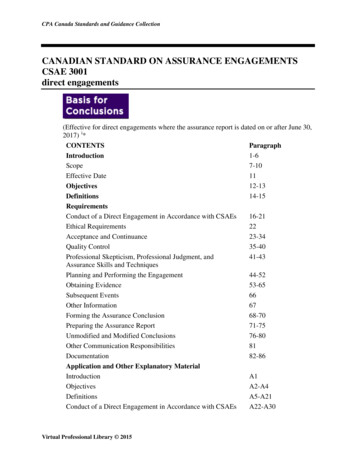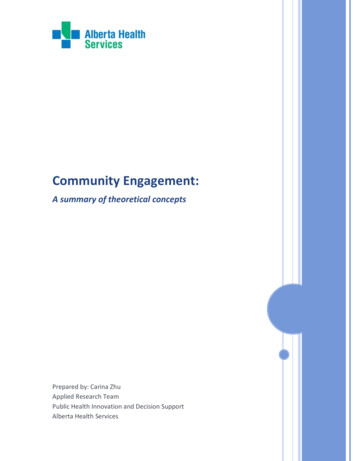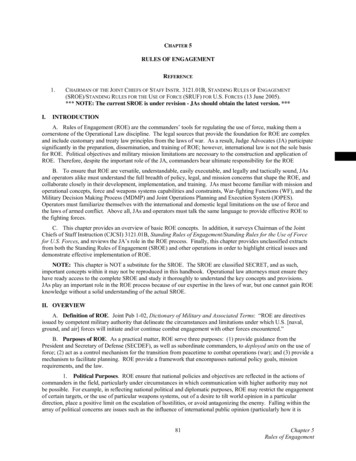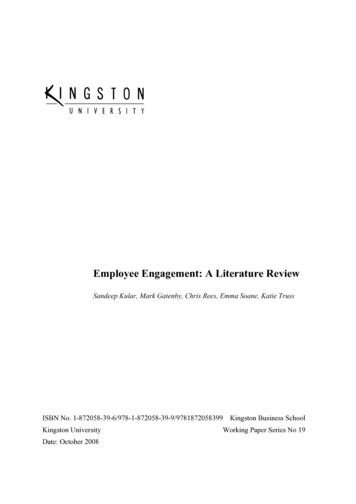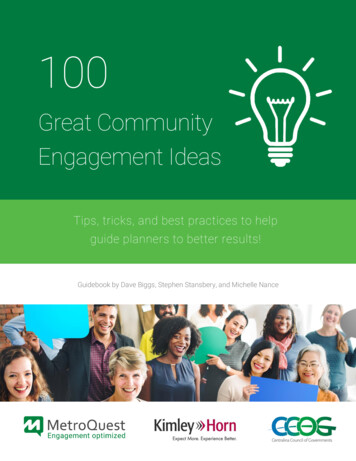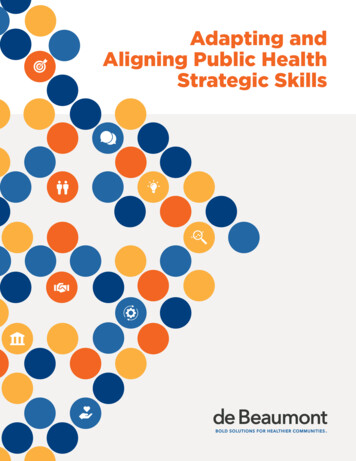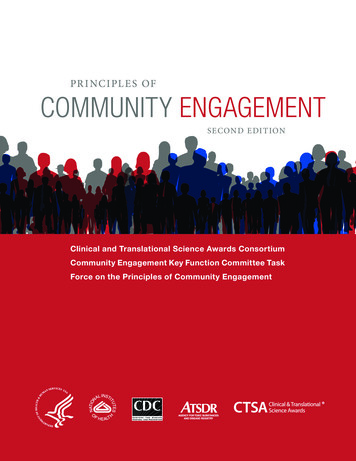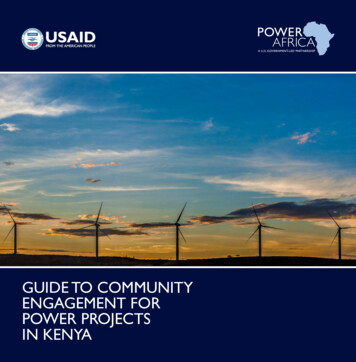
Transcription
GUIDE TO COMMUNITYENGAGEMENT FORPOWER PROJECTSIN KENYA1
ACKNOWLEDGEMENTSMany individuals and organizations contributed to the development of this Guide to Community Engagement for Power Projectsin Kenya. This guide blends the ideas, input, and vision of a wide range of Power Africa partners, including the Governmentof Kenya, energy sector parastatals, power project developers, Kenyan and international finance institutions, civil society, andrepresentatives of Kenya’s many diverse communities.Finally, a special acknowledgement to the staff in Power Africa’s Coordinator’s Office at USAID, the team at USAID Kenya, and allthe staff across U.S. government agencies and departments involved in developing and reviewing this guide.DISCLAIMERThis guide was prepared by Power Africa to assist the community engagement efforts of power project developers in Kenya.At no point should this document or the contents herein be used as a sole or definitive source of information regarding suchpractices or activities.While this document draws on legal resources, it has no legal status or effect whatsoever.The information contained herein isneither intended to be, nor should be used as, a substitute for legal advice. Users of this document are encouraged to conducttheir own legal due diligence and obtain professional legal advice in respect of any applicable statutes and regulations referred toherein. Furthermore, the information contained herein may be affected by changes to the statutes and regulations of Kenya at anytime, without prior notice.Power Africa will accept no liability for the accuracy, completeness or currency of the information sources utilized in thedevelopment of this document. Furthermore, Power Africa shall in no way be held liable or responsible for any loss or damagesresulting from the use of, or reliance on, the contents of this document.Guide to Community Engagement for Power Projects in KenyaPublished by Power Africa, January 2018Available online at: www.usaid.gov/powerafrica/kenyaReproduction of this publication for educational or other non-commercial purposes is authorized without prior writtenpermission from the copyright holders provided that the Guide to Community Engagement for Power Projects in Kenya is cited as thesource of the information. If a copyright is indicated on a photo, graphic, or other material, permission to copy these materialsmust be obtained from the original source.Front & Back Cover Photo:The Lake Turkana Wind Project in Marsabit County is the largest private investment in Kenya’s history. Lake Turkana Wind Project (www.ltwp.co.ke)3
CONTENTSPreface02Foreword03Executive SummaryIntroductionThe Case for Community EngagementConducting Community EngagementAppendices and Annexes05091313What is Community Engagement?14What Does the Law Require?17Why is Community Engagement Important forDeveloping Power Projects?2123Step 1: Planning35Step 2: Engagement48Step 3: Documentation,Monitoring & Evaluation53Master Checklist of Community EngagementActivities and Considerations5960 Appendix 1: Acronyms61 Appendix 2: Glossary63 Appendix 3: References65 Annex 1: Kenyan Laws Pertaining toPublic Participation71Annex 2: Key Stakeholder Groups inKenya’s Power Sector1
PREFACEThe work of increasing access to electricity in sub-SaharanAfrica involves a diverse array of participants, from powerproject developers and financiers, to local governmentagencies, civil society organizations, and the everyday usersof electricity themselves. Often, the most successful powerprojects are those that streamline the path to financialclose by ensuring that the concerns and needs of all partiesare heard and addressed at every stage of the developmentcycle.While this guide was conceived with large-scale powerdevelopers in mind, it can be applied by all infrastructureproject developers working in Kenya, large or small.It is our wish that this guide will serve as a practical manualfor developers to conduct more effective communityengagement programs, that will ultimately lead to win-winprojects for the community, the companies investing inKenya, and for the country as a whole.In Kenya, some recent power projects have experiencedchallenges, delays, and terminations stemming frominsufficient engagement with communities and otherstakeholders.A common theme in these cases is thatcommunity engagement either started too late, or didnot adhere to international benchmarks, such as theInternational Finance Corporation’s Performance Standardson Environmental and Social Sustainability.As part of our support to the Government of Kenya, andto advance our shared goals of bringing new and morereliable electricity to communities across the country,Power Africa produced this Guide to Community Engagementfor Power Projects in Kenya.This guide is designed to helppower generation and transmission project developersplan and conduct more effective, comprehensive, andtransparent community engagement, with an emphasis oncreating positive outcomes for all.Power Africa believes that genuine, robust communityengagement from the early stages of project developmentand all the way through to commissioning, should be a corebusiness best practice. Indeed, community engagementshould be embraced as a means to help de-risk projects,keep transactions on track, and create shared value forcompanies and local stakeholders.Andrew M. Herscowitz, CoordinatorPower Africa2
FOREWORDFor those of us privileged to live and work in Kenya, itis easy to see that her true power is in her people.Thediversity, traditions, and pride of Kenyans are at the heartof the country’s great beauty, and success.In my time as Ambassador, I have had the pleasure andfortune to visit communities from the capital to the coast,farmlands to fishing villages, city neighborhoods, ruralschools, and a vibrant mosaic of places in between. Each ofthese communities is home to people who strive to buildbetter lives for themselves and their families. Increasingaccess to electricity for the people, schools, hospitals,and businesses in these communities is a cornerstone forimproving lives and livelihoods.guide collects the wisdom gleaned from our collectiveexperiences, as well as international best practicescustomized to local context.I encourage developers to put this guide to good use.Share it with your team.Take note of best practices andplan for shared success.Together, we can help shape the future for Kenya andKenya’s people.Asanteni sana.Through Power Africa, the United States has collaboratedclosely with Kenya’s government ministries, energy utilities,private sector companies, and entrepreneurs to expandaccess to electricity across the country. Power Africa ismaking it easier for developers, financiers, and civil societyto join forces on the power projects Kenya needs tosustain its positive trajectory.This Guide to Community Engagement for Power Projects inKenya is a critical addition to the Power Africa partnership.It is designed to advise power project developers onthe most meaningful and empowering approaches tocommunity engagement, and to help deliver reliableelectricity in a way that values Kenyan law, Kenyan cultures,and, most importantly, Kenyan people.Moreover, this guide is meant to help developers andcommunities avoid the kind of impasses that have hinderedKenyan infrastructure projects in recent years.Theseissues have not only impacted Kenya’s ability to realize itsdevelopment objectives, but also resulted in enormousopportunity costs for both the developers and thecommunities.Robert F. GodecU.S. Ambassador to KenyaAs a practical tool, this guide acknowledges the challengesof power project development and related communityengagement, and recommends step-by-step actions to planfor, conduct, and monitor robust community engagement.Case studies and real-world examples from the Kenyancontext also provide tips for what has worked forinfrastructure developers, as well as what to avoid.The3
Photo: Power AfricaConstruction site of the 12 MW biomass project in Baringo County, which uses the invasive mathenge tree to turn a pest into power.4GUIDE TO COMMUNITY ENGAGEMENT FOR POWER PROJECTS IN KENYA
EXECUTIVE SUMMARYKenya is an attractive market for power projectdevelopment, supported by the Kenyan Government’s goalto achieve universal access to electricity by 2020 and aninvestment-friendly climate. However, some recent energygeneration and other development projects were stalledor halted by community opposition that was based onconcerns over project impacts, land ownership, lack ofconsensus regarding benefit sharing, or a combination ofthese and other related issues.WHAT IS COMMUNITY ENGAGEMENT?More to the point: sometimes developers and communitieshave not engaged one another in a meaningful, timely, orproductive way, leading otherwise good projects to getdelayed or derailed altogether.In fact, the Constitution of Kenya, as well as other nationallaws and regulations, contains a multitude of provisionsregarding public participation. Public participation allowsindividuals and communities to contribute to decisionmaking processes by expressing concerns, needs, andvalues.This is the heart of community engagement.This guide is premised on the belief that developersand communities share mutually beneficial goals. Fora developer, goals may include an efficient projectdevelopment cycle leading to delivery of low-cost powerand a profitable business model. For a community, goalsmay include appropriate mitigation for project impacts,compensation for land use, cultural protection, and/or other forms of benefit sharing. Of course, all partiesstand to gain from increased access to electricity and theresulting economic boost.This guide considers community engagement to be afull suite of communication and direct interaction withimpacted communities that, ideally, leads to communityconsent for a project.The recommended engagementactivities outlined herein are rooted in international bestpractices and Kenyan legal frameworks and are tailored foruse in the Kenyan cultural context.Achieving these goals in a way that brings positiveoutcomes for all parties requires meaningful, consistent,and empowering community engagement.EXECUTIVE SUMMARY5
WHY IS COMMUNITY ENGAGEMENTIMPORTANT FOR DEVELOPING POWERPROJECTS?Power projects in Kenya, particularly those requiring newtransmission lines, typically require a substantial amountof land. Land ownership is one of the most emotive andpolitical issues in Kenya, meaning the land acquisitionprocess can be extremely sensitive and challenging.Unsurprisingly, land-related issues are the biggest source ofcommunity grievances against development projects.For these reasons, community engagement is criticalto ensure accuracy and transparency in the landacquisition component of a project, to ensure fairness incompensation and/or other benefits shared with affectedcommunities, and to understand and manage communitygrievances.Indeed, the practice of engaging communities specificallyand only to meet licensing and permitting requirements, orwhen troubles arise, is a practice that leads to communitydissatisfaction. It is an approach that can very well leadto an environment of enmity between stakeholders anddevelopers.The Ministry of Energy and Petroleum (MoEP) and theEnergy Regulatory Commission (ERC) require developersto obtain a record of “no objection” from the communitywithin which the project is located prior to issuance ofapproval to proceed with the project.Moreover, best practices from around the worlddemonstrate that community engagement should besystematically integrated into the core business activities ofdevelopment projects to:1. Achieve a lower overall risk profile for the project2. Avoid the likelihood of disputes and/or grievances3. Avoid cost and/or time overruns during constructionTherefore, community and stakeholder engagement shouldbe afforded the necessary human and financial resources tosupport long-term project objectives.Best practices also maintain that community engagement isnot an event with a distinct start and end; rather it shouldbe a continuous process that begins while determiningproject feasibility, increases concurrently with developmentof the base case and investment of capital, is maintainedthrough the process of attracting finance through financialclose, and is repeatedly monitored and evaluated so it canbe enhanced throughout the project’s lifecycle.INTEGRATING COMMUNITY ENGAGEMENT WITH THE PROJECT CYCLESTAGE 1STAGE 2STAGE 3STAGE 4Determine project viability andbase case option to supportcommitment of funding forfeasibility studyRefine base case to supportcommitment of resourcesto develop the project andinvest capital; Undertake longlead time activities and obtainauthorizationsStructure project to attractfinance;Arrange finance on termsand conditions sufficient toexecute all project agreements;Reach financial closeCommence construction andreach commercial operationsdate (COD)EarlyStage6ProjectDevelopmentGUIDE TO COMMUNITY ENGAGEMENT FOR POWER PROJECTS IN KENYAArranging Finance/Financial CloseProject Construction& Completion
CONDUCTING COMMUNITY ENGAGEMENTConducting a strong community engagement program begins with an adherence to a core set of principles:Careful Planning& PreparationProactiveConsultation& Sourcing ofFeedbackCollaboration& SharedPurposeLearning,Accountability& TrustGenderEquality& FemaleEmpowermentDisclosure& Access ppropriatenessIntegrity,Transparency& HonestyManage &AddressGrievancesDoNo HarmSustainedEngagementThroughoutStep 1 is the Planning Phase, and entails staffing,budgeting, and stakeholder identification and mapping.Identifying and analyzing the project’s stakeholders isessential to determine potential supporters and partners,as well as those who may oppose the project.Step 2 is the Engagement Phase, and involves directcommunication with stakeholders, community capacitybuilding, negotiation processes, addressing grievances, andbenefit sharing agreements.STEP 1PLANNINGStep 3 is Monitoring and Evaluation, where adeveloper can identify any room for improvement in theirengagement activities, and calculate the return on theircommunity engagement-related investments.A samplechecklist of indicators to monitor is provided.For sustainable developer/community relations, it isnecessary to have continuous feedback between thecommunity and the project developer throughout theproject cycle and at each decision-making stage.Finally, this guide presents a master checklist of communityengagement activities and considerations, designed as a “todo” list for power project developers in Kenya.Adheringto these best practices can help bring to fruition mutuallybeneficial projects desired by developers and communitiesalike.STEP 2ENGAGEMENTSTEP 3DOCUMENTATION,MONITORING &EVALUATIONEXECUTIVE SUMMARY7
Photo: Power AfricaMany rural communities, like this one in Narok County, are relatively isolated.8GUIDE TO COMMUNITY ENGAGEMENT FOR POWER PROJECTS IN KENYA
INTRODUCTIONDevelopers and sponsors of power projects aim to delivernew electricity services as quickly, safely, and economicallyas possible.Among the many important steps to becompleted before “flipping the switch” is a comprehensiveand meaningful community engagement process with thepeople and organizations that may be impacted by theproposed project. This Guide to Community Engagementfor Power Projects in Kenya provides suggestions to helpdevelopers plan and execute successful communityengagement efforts in Kenya, with a focus on creatingpositive outcomes for all.Often, developers point to the length of time it cantake for projects to reach financial close as a reason fornot investing more in building their relationship with acommunity.This reasoning can result in an enormousopportunity cost, as effective community engagementmay play a major role in reaching financial close byenhancing the project’s ultimate bankability. This guidewas developed to shed light on the importance ofcommunity engagement as good business practice andproposes an approach contextualized to the Kenyansituation.Kenya has seen examples of both well-received and morechallenged generation projects in recent years. Concernshave related to real or perceived health, environmental,cultural/social impacts, lack of consensus regardingcompensation and/or benefit sharing, conflicting interestsof different factions of the community or between thecommunity and the developer, or a combination of any orall of the above.A common theme regarding the failure of some largescale development projects in Kenya appears to bethat community engagement a) was not conducted asthoroughly as it could or should have been, b) did not startearly enough, or c) was of sub-standard quality.Althoughpublic participation is required by law in Kenya,1 there are ahost of documented complaints of inadequate engagement,particularly related to claims of insufficient involvement bythe community in decision-making.See “What does the Law Require?” section on page 14.1INTRODUCTION9
PURPOSE & OBJECTIVESTo advance our shared goals of bringing new and morereliable electricity to communities in Kenya, Power Africadeveloped this guide to specifically assist power generationand transmission project developers to plan and conductmore effective, robust, and transparent communityengagement.While it was developed with large-scale powerdevelopers in mind, it can be of use to all infrastructureproject developers working in Kenya, large or small.The objectives of this guide are to: Provide a suggested model for developers to use foreffective community participation and collaborationthroughout the project lifecycle, to help projects reachfinancial close and achieve commercial operation tothe benefit of the country;Identify the best methods for project developers toprovide communities with balanced and objectiveinformation on proposed projects and to obtain theirfeedback;Develop strategies for developers to build strong andeffective relationships with stakeholders, including thecommunities, regulatory officials, local and nationalgovernment officials, etc.;Develop best practices for development projects insocial and environmental engagement;Ensure integration of measures to promote genderequality in community engagement activities, includingpromoting women as leaders;Integrate considerations for marginalized groups withinthe community, including ethnic minorities, persons withdisabilities, vulnerable women, and children;Provide tools for effective resolution of communityissues during project implementation; andContinuously improve developers’ communityengagement practices through self-monitoring andevaluation of their activities.A BUSINESS CASE FOR THOROUGHCOMMUNITY ENGAGEMENTTo implement a robust community engagement strategy,developers should commit sufficient human and financialresources just as they would budget for other operationalcomponents of the project. Having the right people tomanage this aspect of the project, equipped with anadequate budget with which to work, is as important ashaving the right engineers.Adequately resourced community engagement serves asan effective risk mitigation strategy for both constructionand operations phases of any project. Success in this regardmay help project sponsors, investors, and lenders to:1. Achieve a lower overall risk profile of the project,leading to more competitive financing terms/less onerouslender requirements, higher equity returns, and/or lowerend-consumer tariffs;2. Avoid the likelihood of any dispute resolution (andin extreme cases costly and lengthy litigation and/orarbitration);3. Avoid cost and/or time overruns during construction,leading to funding shortfalls (and in extreme casesleading to prolonged or permanent default of the project,followed by a step-in by lenders and a partial or full lossof equity investment).WHAT THIS GUIDE IS NOTThis guide does NOT replace the requirements of thepolicy, legal and regulatory framework in which anydevelopment project must operate in Kenya. At no pointshould this document or the contents herein be used asa sole or definitive source of information regarding thepractices of development partners, financiers or investors.This guide is not intended to be, and should not be used as,a substitute for legal advice.10GUIDE TO COMMUNITY ENGAGEMENT FOR POWER PROJECTS IN KENYA
HOW & WHEN TO USE THIS GUIDEStakeholder and community engagement is a continuousprocess required throughout a project’s lifecycle. Ifconducted well, community engagement can both benefitlocal communities and pay important dividends in terms ofavoiding or lessening delays due to unresolved communityconcerns, or even avoid costly lawsuits.The approach of only engaging communities specificallyto meet licensing and permitting requirements, or whentroubles arise, is a practice that leads to dissatisfaction and acombative or defensive engagement with the community.Community engagement should be regarded as a meansto foster mutually beneficial and sustainable relationshipsbetween the developer and the community, withcontinuous feedback at each project decision-making stage,from development to construction to operation.HOW WE DEVELOPED THIS GUIDEThis guide was informed by a triangulation of informationfrom an assessment study conducted in 2016/2017, whichconsisted of: Photo: Power Africa/Ryan KilpatrickThis guide is, therefore, intended to be used at every stage of theproject cycle.The depth of engagement, its intended outcomes,and its nature is likely to change over time as a developer buildstrust with the community.The principles set forth in this guideshould, however, be observed at all times.An analysis of the policies, laws, and regulations ofKenya dealing with public participation;A study of international good case practice incommunity engagement, including the InternationalFinance Corporation (IFC) Performance Standardson Environmental and Social Sustainability, 20122, andother best practices from developers’ experiences,contextualized for the Kenyan landscape;Observation of and consultation with various PowerAfrica stakeholders (including Non-governmentalorganizations (NGOs), developers, communityorganizations, all levels of government and financiers),as well as other infrastructure development actorswho play an active part in stakeholder engagementwith a focus on community engagement.The solar carport at the Garden City Mall in Nairobi is Africa’s largest commercial or industrial solar-as-a-service project.International Finance Corporation Performance Standards on Environmental and Social Sustainability, January 20122INTRODUCTION11
Photo: USAID/Eric OnyiegoTraditional dances, like this one by the Turkana people, are often part of community engagement welcoming ceremonies.12GUIDE TO COMMUNITY ENGAGEMENT FOR POWER PROJECTS IN KENYA
THE CASE FOR COMMUNITYENGAGEMENTWHAT IS COMMUNITY ENGAGEMENT?Before we can define community engagement, we needto consider what we mean by the word community. Forpurposes of this guide, community refers to a group ofpeople who have common interests and values livingin a definable geographic area that would host or beadjacent to, or otherwise impacted by, a proposed powerdevelopment project.Depending on the situation, community engagement canmean different things to different people. Sometimes itconnotes simple communication with the communityor education of the community, or what some call“sensitization.” Others use it in the context of extensionservices, such as those provided by agricultural agencies,community health workers, etc.These approaches mightbe considered low levels of community engagement, ofone-way communication or information delivery with theprimary goal of delivering information.The next level of community engagement is consultation,as in seeking the views of the community. But consultationdoes not necessarily lead to the integration of the viewsor wishes of a community into the decision-makingprocess or final project design.This level of engagement isusually conducted to simply inform the community of thedevelopment project, and to determine their perceptionsof the project.INDICATIVE LEVELS OF COMMUNITY ENGAGEMENTINFORMProvide balanced,objective, accurateand consistentinformation tohelp stakeholdersunderstand theproblem, alternatives,opportunities and/orsolutions.CONSULTObtain feedbackfrom stakeholders onanalysis, alternativesand/or outcomes.INVOLVEWork directlywith stakeholdersthroughout theprocess to ensurethat their concernsand needs areconsistentlyunderstood andconsidered.COLLABORATEPartner with thestakeholder todevelop alternatives,make decisions, andidentify preferredsolutions.EMPOWERPlace final decisionmaking in the handsof the stakeholder.Stakeholders areenabled/equipped toactively contribute tothe achievement ofoutcomes.Adapted from the International Association for Public Participation (IAP2) Public Participation Spectrum, 0001/files/IAP2 Public Participation Spectrum.pdf)THE CASE FOR COMMUNITY ENGAGEMENT13
WHAT DOES THE LAW REQUIRE?These basic levels of community engagement, though,do not go far enough to capture the level andcomprehensiveness necessary to engage the communityin a way that truly respects their history, traditionalknowledge, cultural norms, relationship with the land onwhich they live, the natural resources they utilize, and theirlegal and human rights.The Constitution of Kenya provides a strong foundationfor participatory governance.While the Constitution doesnot use the term community engagement, it is replete withprovisions on public participation, and establishes publicparticipation as a key value and principle in governance.5Hence, more evolved definitions refer to communityengagement as public participation or working in partnershipwith the community, or even as participative democracy.These definitions incorporate the aspects of collaboration,negotiation and empowerment to foster collaborativedecision-making and empowered action with communityconsent, and perhaps even partnership as the key outcomes.Public participation is a deliberative process in which thepublic is involved in problem-solving or decision-making inpolicy formulation, legislation, or project implementation. It isa process by which community concerns, needs, and valuesare incorporated into government and corporate decisionmaking. Public participation is variously referred to as engagingstakeholders, citizens, or communities.This guide considers community engagement as a fullsuite of communication and direct interaction activitieswith impacted communities that, ideally, leads tocommunity consent for a project. This approach includesthe dissemination of information, targeted consultationwith local leaders and representative groups,3 collaborativedecision-making, and perhaps even community co-design ofthe project.Public participation recognizes the diversity of groupaspirations, needs, and values, and permits collective decisionmaking, thereby allowing consensus designed to achieve morelegitimate policies.The essence of public participation is tostrengthen and deepen democratic governance.A CASE FOR TRANSPARENT AND CONTINUOUSCOMMUNITY ENGAGEMENTFrom a review of civil suits in Kenya with complaintscentered around public participation, the issue of lack ofa continued engagement with the community was raisedin at least one case, Mui Coal Basin Community v. FenxiMining Industry Company Limited and Others.4 Mui CoalBasin Community complained that there was a lack oftransparency administered in awarding the tender, andthat discussions on how to share the benefits from thecoal mining process did not involve the community. In hisruling, the judge ordered that Fenxi should continue toengage with the local community and provide reasonableopportunities for public participation during the processof preparing the Environmental Impact Assessment(EIA) and the process of resettlement, as outlined in theBenefits Sharing Agreement between the Governmentof Kenya and Fenxi, including the sharing of benefits withthe community.Source: www.kenyalaw.org/caselaw/cases/view/117704/Public participation is now a primary requirement inall policy and statutory functions of Kenya’s executiveand legislature. Public participation is also an inherentrequirement in the planning and execution of projects thathave an impact on the social or economic life of communities,and is a specific stipulation in all projects with an impact onthe environment.The objective for this requirement is toinvolve communities in all decisions that touch on their lives.In addition, almost all of Kenya’s statutory instruments enactedafter the promulgation of the Constitution in 2010 containprovisions on public participation, with which developersare required to comply.The statutes require that publicparticipation is initiated at all stages of policy development andproject implementation. Public participation is regarded as anobligatory and collaborative process, serving to infuse citizens’values and priorities in legislation to increase transparency andaccountability. In project implementation, public participationis geared at obtaining a buy-in and acceptance in thecommission of any venture in communities.The table on page15 lists applicable public participation legislation.These should include women, youth, and/or any other marginalized or vulnerablegroups.Constitutional Petition No. 305 of 2012, Ruling dated September 18, 20155The Constitution of Kenya, Article 10(2)(a), 20103414GUIDE TO COMMUNITY ENGAGEMENT FOR POWER PROJECTS IN KENYA
APPLICABLE PUBLICPARTICIPATION LEGISLATIONThe Constitution of Kenya, 2010The Employment Act, 2007The Urban Areas and Cities Act, 2011County Governments Act, 2012Intergovermental Relations Act, 2012Land Registration Act, 2012National Land Commi
Guide to Community Engagement for Power Projects in Kenya is a critical addition to the Power Africa partnership. It is designed to advise power project developers on the most meaningful and empowering approaches to community engagement, and to help deliver reliable elec
